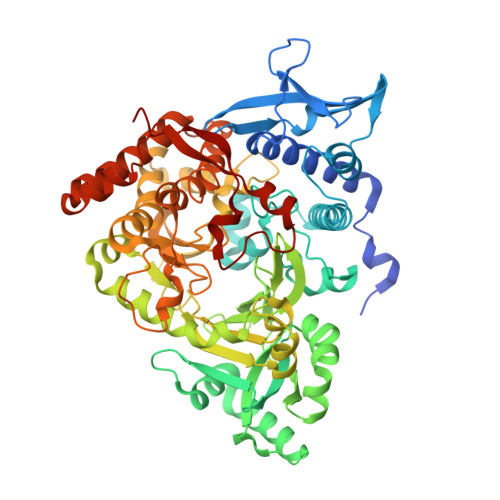An acyl-adenylate mimic reveals the structural basis for substrate recognition by the iterative siderophore synthetase DesD.
Yang, J., Banas, V.S., Patel, K.D., Rivera, G.S.M., Mydy, L.S., Gulick, A.M., Wencewicz, T.A.(2022) J Biological Chem 298: 102166-102166
- PubMed: 35750210
- DOI: https://doi.org/10.1016/j.jbc.2022.102166
- Primary Citation of Related Structures:
7TGJ, 7TGK, 7TGL, 7TGM, 7TGN - PubMed Abstract:
Siderophores are conditionally essential metabolites used by microbes for environmental iron sequestration. Most Streptomyces strains produce hydroxamate-based desferrioxamine (DFO) siderophores composed of repeating units of N 1 -hydroxy-cadaverine (or N 1 -hydroxy-putrescine) and succinate. The DFO biosynthetic operon, desABCD, is highly conserved in Streptomyces; however, expression of desABCD alone does not account for the vast structural diversity within this natural product class. Here, we report the in vitro reconstitution and biochemical characterization of four DesD orthologs from Streptomyces strains that produce unique DFO siderophores. Under in vitro conditions, all four DesD orthologs displayed similar saturation steady-state kinetics (V max = 0.9-2.5 μM⋅min -1 ) and produced the macrocyclic trimer DFOE as the favored product, suggesting a conserved role for DesD in the biosynthesis of DFO siderophores. We further synthesized a structural mimic of N 1 -hydroxy-N 1 -succinyl-cadaverine (HSC)-acyl-adenylate, the HSC-acyl sulfamoyl adenosine analog (HSC-AMS), and obtained crystal structures of DesD in the ATP-bound, AMP/PP i -bound, and HSC-AMS/P i -bound forms. We found HSC-AMS inhibited DesD orthologs (IC 50 values = 48-53 μM) leading to accumulation of linear trimeric DFOG and di-HSC at the expense of macrocyclic DFOE. Addition of exogenous PP i enhanced DesD inhibition by HSC-AMS, presumably via stabilization of the DesD-HSC-AMS complex, similar to the proposed mode of adenylate stabilization where PP i remains buried in the active site. In conclusion, our data suggest that acyl-AMS derivatives may have utility as chemical probes and bisubstrate inhibitors to reveal valuable mechanistic and structural insight for this unique family of adenylating enzymes.
- Department of Chemistry, Washington University in St Louis, St Louis, Missouri, USA.
Organizational Affiliation:






















